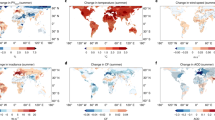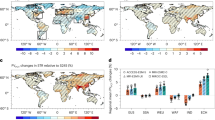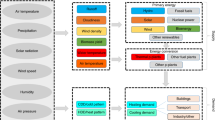Abstract
Regardless of the harmful effects of burning fossil fuels on global climate1,2, other energy sources will become more important in the future because fossil fuels could run out by the early twenty-second century3 given the present rate of consumption4. This implies that sooner or later humanity will rely heavily on renewable energy sources. Here we model the effects of an idealized large-scale application of renewable energy on global and regional climate relative to a background climate of the representative concentration pathway 2.6 scenario (RCP2.6; ref. 5). We find that solar panels alone induce regional cooling by converting incoming solar energy to electricity in comparison to the climate without solar panels. The conversion of this electricity to heat, primarily in urban areas, increases regional and global temperatures which compensate the cooling effect. However, there are consequences involved with these processes that modulate the global atmospheric circulation, resulting in changes in regional precipitation.
This is a preview of subscription content, access via your institution
Access options
Subscribe to this journal
Receive 12 print issues and online access
$209.00 per year
only $17.42 per issue
Buy this article
- Purchase on Springer Link
- Instant access to full article PDF
Prices may be subject to local taxes which are calculated during checkout


Similar content being viewed by others
References
IPCC in Climate Change 2014: Impacts, Adaptation, and Vulnerability (eds Field, C. B. et al.) (Cambridge Univ. Press, 2014).
IPCC in Climate Change 2013: The Physical Science Basis (eds Stocker, T. F. et al.) (Cambridge Univ. Press, 2013).
Shafiee, S. & Topal, E. When will fossil fuel reserves be diminished? Energy Policy 37, 181–189 (2009).
Key World Energy Statistics (International Energy Agency, 2013).
Van Vuuren, D. P. et al. RCP2.6: Exploring the possibility to keep global mean temperature increase below 2 °C. Clim. Dynam. 109, 95–116 (2011).
International Energy Outlook 2013 DOE/EIA-0484 (US Energy Information Administration, US Department of Energy, 2013).
Rogner, H.-H. et al. Global Energy Assessment-Toward a Sustainable Future Ch. 7, 423–512 (Cambridge Univ. Press and the International Institute for Applied Systems Analysis, 2012).
Kamat, P. V. Meeting the clean energy demand: Nanostructure architectures for solar energy conversion. J. Phys. Chem. 111, 2834–2860 (2007).
Gent, P. R. et al. The Community Climate System Model version 4. J. Clim. 24, 4973–4991 (2011).
Oleson, K. W., Bonan, G. B., Feddema, J. & Jackson, T. An examination of urban heat island characteristics in a global climate model. Int. J. Clim. 31, 1848–1865 (2010).
Clarke, L. et al. in Climate Change 2014: Mitigation of Climate Change (eds Edenhofer, O. et al.) 413–510 (IPCC, Cambridge Univ. Press, 2014).
Rephaeli, E. & Fan, S. Absorber and emitter for solar thermo-phtovoltaic systems to achieve efficiency exceeding the Shockley–Queisser limit. Opt. Express 17, 15145–15159 (2009).
Bermel, P. et al. Design and global optimization of high-efficiency thermophotovoltaic systems. Opt. Express 18, A314–A334 (2010).
Chukwula, C. & Folly, K. A. Overview of concentrated photovoltaic (CPV) cells. J. Power Energy Eng. 2, 1–8 (2014).
Lenert, A. et al. A nanophotonic solar thermophotovoltaic device. Nature Nanotech. 9, 126–130 (2014).
Kurokawa, K. et al. (eds) Energy from the Desert: Very Large Scale Photovoltaic System (Earthscan, 2007).
Meehl et al. in Climate Change 2007: The Physical Science Basis (eds Solomon, S. et al.) 747–845 (IPCC, Cambridge Univ. Press, 2007).
Millstein, D. & Menon, S. Regional climate consequences of large scale cool roof and photovoltaic array deployment. Environ. Res. Lett. 6, 034001 (2011).
Taha, H. The potential for air-temperature impact from large scale deployment of solar photovoltaic arrays in urban areas. Sol. Energy 91, 358–367 (2013).
Masson, V. et al. Solar panels reduce both global warming and urban heat island. Front. Environ. Sci. 2, 14 (2014).
Collins, M. et al. in Climate Change 2013: The Physical Science Basis (eds Stocker, T. F. et al.) 1029–1136 (Cambridge Univ. Press, 2013).
Zhang, G. J., Cai, M. & Hu, A. Energy consumption and the unexplained winter warming over northern Asia and North America. Nature Clim. Change 3, 466–470 (2013).
Acknowledgements
A portion of this study was supported by the Regional and Global Climate Modelling Program (RGCM) of the US Department of Energy’s Office of Science (BER), Cooperative Agreement No. DE-FC02-97ER62402. This research used computing resources of the Climate Simulation Laboratory at the National Center for Atmospheric Research (NCAR), which is sponsored by the National Science Foundation; the Oak Ridge Leadership Computing Facility, which is supported by the Office of Science of the US Department of Energy under Contract DE-AC05-00OR22725. The National Center for Atmospheric Research is sponsored by the National Science Foundation.
Author information
Authors and Affiliations
Contributions
A.H. designed and led the study. A.H., S.L., G.A.M., W.H., W.M.W., K.W.O., B.J.v.R., M.H. and W.G.S. contributed to the model simulations, data analysis, and all authors actively contributed towards writing the manuscript.
Corresponding author
Ethics declarations
Competing interests
The authors declare no competing financial interests.
Supplementary information
Rights and permissions
About this article
Cite this article
Hu, A., Levis, S., Meehl, G. et al. Impact of solar panels on global climate. Nature Clim Change 6, 290–294 (2016). https://doi.org/10.1038/nclimate2843
Received:
Accepted:
Published:
Issue Date:
DOI: https://doi.org/10.1038/nclimate2843
This article is cited by
-
Large-scale photovoltaic solar farms in the Sahara affect solar power generation potential globally
Communications Earth & Environment (2024)
-
Comprehensive guidance for optimizing the colloidal quantum dot (CQD) Perovskite solar cells: experiment and simulation
Scientific Reports (2023)
-
The characteristics and parameterizations of the surface albedo of a utility-scale photovoltaic plant in the Gobi Desert
Theoretical and Applied Climatology (2023)
-
A comparative study on surface energy flux characteristics of photovoltaic power station in Gobi in summer
Theoretical and Applied Climatology (2022)
-
Physical analysis of the environmental impacts of fishery complementary photovoltaic power plant
Environmental Science and Pollution Research (2022)



